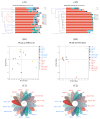Bioaccumulation, Ecotoxicity, and Microbial Responses in Hoplobatrachus rugulosus Tadpoles Following Co-Exposure to Imidacloprid and Microplastics
- PMID: 40646827
- PMCID: PMC12249034
- DOI: 10.3390/ani15131928
Bioaccumulation, Ecotoxicity, and Microbial Responses in Hoplobatrachus rugulosus Tadpoles Following Co-Exposure to Imidacloprid and Microplastics
Abstract
Agricultural organic pollutants have been identified as a key factor contributing to amphibian population decline, particularly during early developmental stages when tadpoles are frequently exposed to neonicotinoids (NEOs) and microplastics (MPs). In this study, Hoplobatrachus rugulosus tadpoles were exposed to imidacloprid (IMI: 0.045, 0.45, and 4.5 mg L-1) and polyethylene-derived MPs (10 mg L-1) from agricultural mulch films, both individually and in combination. We systematically evaluated acute toxicity, bioaccumulation, developmental and oxidative stress responses, and changes in the skin and gut microbiota. The results showed that the 96 h median lethal concentration (LC50) of IMI was 44.8 mg L-1 in the IMI-only group and was 40.5 mg L-1 in the IMI + MPs group, indicating the negligible impact of MPs on acute toxicity. However, in the highest co-exposure group (IMI4.5 + MPs), tadpole body length and weight decreased by 14.7% and 22.6%, respectively, alongside marked changes in oxidative stress, whereby catalase (CAT) and superoxide dismutase (SOD) activities were suppressed, while malondialdehyde (MDA) levels increased by 35%, indicating elevated lipid peroxidation. Furthermore, the micronucleus frequency in erythrocytes was significantly elevated, suggesting genotoxic effects. Microbial community analysis revealed significant shifts in the relative abundance of gut and skin microbiota under IMI + MPs exposure, with a notable enrichment of Proteobacteria, Fusarium, Actinomycetota, and Bacteroidota, indicating the disruption of host-microbiome interactions. This study proposes a comprehensive multi-tiered assessment framework encompassing environmental exposure, bioaccumulation, toxicological endpoints, oxidative stress biomarkers, and microbiome shifts. Our findings provide new mechanistic insights and quantitative evidence on the compound threats posed by IMI and MPs to amphibians in aquatic environments.
Keywords: combined toxicity; imidacloprid; microbial diversity; microplastic; tadpole; toxicokinetics.
Conflict of interest statement
We declare that we have no financial or personal relationships with other people or organizations that can inappropriately influence our work, there is no professional or other personal interest of any nature or kind in any product, service, and/or company that could be construed as influencing the position presented in, or the review of, the manuscript entitled.
Figures





Similar articles
-
The Black Book of Psychotropic Dosing and Monitoring.Psychopharmacol Bull. 2024 Jul 8;54(3):8-59. Psychopharmacol Bull. 2024. PMID: 38993656 Free PMC article. Review.
-
Imidacloprid impacts oxidative stress and neurotoxic biomarkers in different marine organisms (fish, mysid and clamworm).Comp Biochem Physiol C Toxicol Pharmacol. 2025 Nov;297:110292. doi: 10.1016/j.cbpc.2025.110292. Epub 2025 Jul 16. Comp Biochem Physiol C Toxicol Pharmacol. 2025. PMID: 40680873
-
Interactive effects of hydrodynamics and microplastics on bioaccumulation, histopathological alterations, biomarker responses, and gene expression in grass carp brain.Ecotoxicol Environ Saf. 2025 Sep 1;302:118596. doi: 10.1016/j.ecoenv.2025.118596. Epub 2025 Jul 1. Ecotoxicol Environ Saf. 2025. PMID: 40602160
-
Hepatotoxicity of imidacloprid in zebrafish and the alleviating role of 10-hydroxy-2-decenoi acid: Insights into oxidative stress, inflammation, and gut microbiota.J Hazard Mater. 2025 Aug 15;494:138695. doi: 10.1016/j.jhazmat.2025.138695. Epub 2025 May 20. J Hazard Mater. 2025. PMID: 40412317
-
Sertindole for schizophrenia.Cochrane Database Syst Rev. 2005 Jul 20;2005(3):CD001715. doi: 10.1002/14651858.CD001715.pub2. Cochrane Database Syst Rev. 2005. PMID: 16034864 Free PMC article.
References
-
- Llorens E., Ginebreda A., la Farré M., Insa S., González-Trujillo J.D., Munné A., Solà C., Flò M., Villagrasa M., Barceló D., et al. Occurrence of regulated pollutants in populated Mediterranean basins: Ecotoxicological risk and effects on biological quality. Sci. Total Environ. 2020;747:141224. doi: 10.1016/j.scitotenv.2020.141224. - DOI - PubMed
-
- Zhou X., Deng Y., Wang R., Wang F., Cui H., Hu D., Lu P. Toxic effects of imidacloprid and sulfoxaflor on Rana nigromaculata tadpoles: Growth, antioxidant indices and thyroid hormone-related endocrine system. Arab. J. Chem. 2023;16:104723. doi: 10.1016/j.arabjc.2023.104723. - DOI
Grants and funding
LinkOut - more resources
Full Text Sources
Miscellaneous

